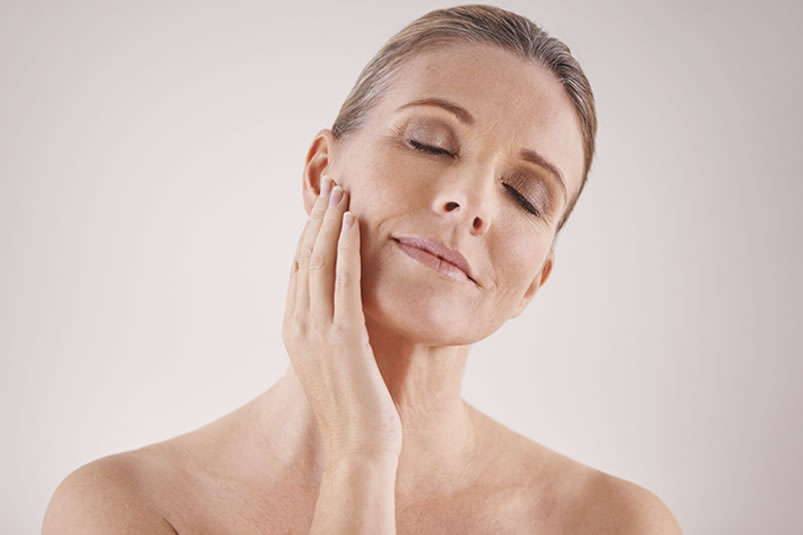
Gravity, sun exposure and the stresses of daily life can take their toll on our faces and necks. Deep creases appear beside the mouth, the jaw line slackens and becomes jowly; and the neck develops loose folds and fat deposits. Facelifts counteract these signs of aging by tightening muscle, removing fat and trimming excess skin giving your face a fresher more youthful look. After surgery, some patients can look 10 to 15 years younger.
What can a facelift do for me?
Facelifts, technically known as rhytidectomies (removal of wrinkles) rejuvenate the mid- to lower face and neck. Facelifts are most effective for patients who want to correct:
- Midface sagging
- Deep creases under the eyes
- Deep creases between the nose and mouth (nasolabial folds)
- Jowls due to loss of muscle tone
- Sagging areas of fat
- Loose skin and fat under the chin and jaw
What a facelift will not correct?
Facelifts can produce a dramatic improvement in one’s appearance with the problems mentioned above. However, facelifts do not stop the aging process and signs of aging will gradually appear once again. Facelifts will not rejuvenate the brow, eyelids, nose and some of the midface. Patients who want to improve these areas may consider combining a facelift with a brow lift or eyelid surgery (blepharoplasty). Injectable soft-tissue fillers, facial implants and skin resurfacing can also enhance the effects of a facelift.
Am I a good candidate for a facelift?
The best candidates for rhytidectomy:
- Wish to improve one or more of the signs of aging as indicated above.
- Men or women whose faces have begun to sag but whose skin still has some elasticity.
- Generally healthy
- Realistic expectations
- Considering a facelift for personal reasons not due to pressure
During your consultation, Dr. Kurtzman will discuss whether a facelift is right for you.
How is Rhytidectomy performed?
Facelifts are typically outpatient procedures and may be performed in an office-based facility, surgery center or hospital. Patients may have a choice of IV sedation or general anesthesia. The procedure takes about two hours. The way a facelift is performed varies depending on the surgeon, the patient’s facial structure and the extent of desired. The three most common incision techniques are:
Traditional facelift: The “full” facelift for rejuvenating the face, jowls and neck including fat sculpting, lifting and repositioning of muscle and deeper tissues, and skin trimming and redraping. The incision begins at the temples and travels down to the front of the ear, around the earlobe, and behind the ear to the lower scalp at the hairline. Sometimes, another incision is made under the chin.
Limited incision facelift: For limited rejuvenation around the eyes and mouth including nasolabial folds and other deep creases. Short incisions are made at the temples and around the ear, and possibly in the lower eyelids and/or under the upper lip.
Neck lift: Concentrates on jowls, loose skin on the neck and fat under the chin. The incision is made around the ear lobe and behind the ear to the lower scalp.
In all three methods, incisions are closed with stitches or tissue glue. Scars are hidden in the hairline and naturally contour the face.
What is a Mid-facelift?
Mid-facelift restores youthful vitality to the mid-face lifting the cheeks and smoothing the smile lines to achieve a natural, rejuvenated look without the need to undergo a full facelift. Mid-facelifts are ideal for reducing puffiness under the eyes, improving the contour of the upper cheeks and correcting nasolabial folds. Incisions are small and hidden in the eyelids or in the mouth. Mid-facelifts are often performed in conjunction with lower-lid blepharoplasty to rejuvenate the area around the eyes or with implants to accentuate the cheeks.
What is recovery from a facelift like?
After your facelift, Dr. Kurtzman will wrap the incisions in bandages and may place drainage tubes in the area. The tubes will be taken out the next day. If surgical clips are used to hold the incisions closed, they will be removed one week after the facelift along with your stitches.
At first, you may experience swelling, numbness, bruising, and a feeling of tightness or tension in the face and neck. Your face may look uneven or distorted, and your facial muscles may feel stiff. Most of these usually resolve within 3 to 6 weeks and sensation typically returns to normal within a few months. In time, scars become less red, raised, lumpy or itchy.
Many patients return to work by the third week. Camouflage cosmetics can be used to minimize the appearance of bruising. You should be gentle with your skin and hair as you recover. Men may need to shave behind the neck and ears where areas of beard-growing skin have moved.


